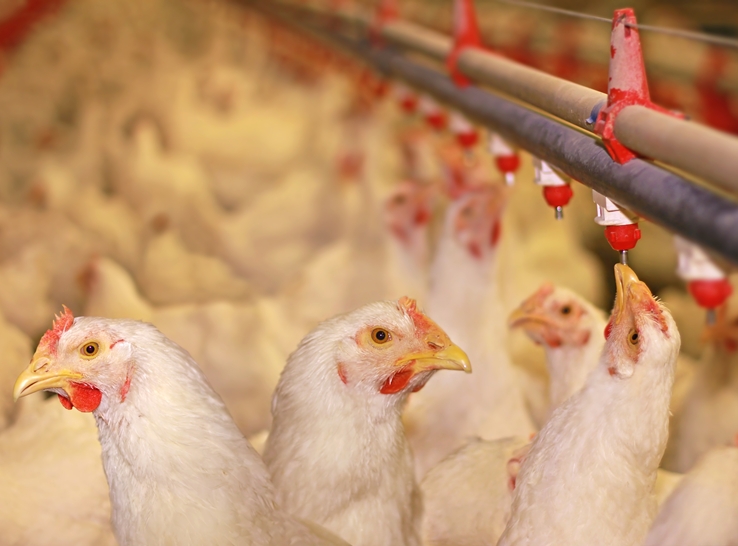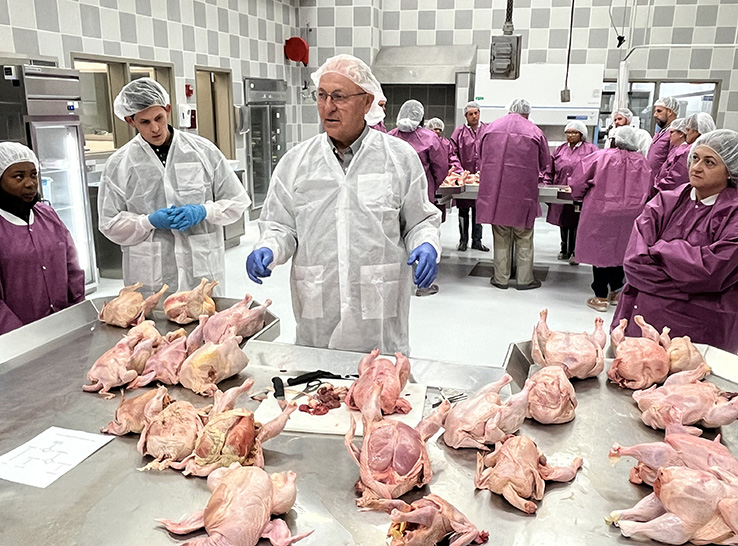A Salmonella vaccine designed to fight the Enteritidis serotype with decreased susceptibility to ciprofloxacin (DSC) performed well in a research trial at the USDA Agricultural Research Service’s (ARS) National Animal Disease Center (NADC), in Ames, Iowa.
The live, attenuated USDA Salmonella vaccine significantly reduced intestinal colonization and movement of DSC Enteritidis to the spleen in broiler chickens. It also prevented DSC Enteritidis dissemination to the bone marrow.
“Vaccination can reduce Salmonella in animals raised for food, and that is going to decrease transmission to vulnerable animals and reduce environmental contamination,” reported Shawn Bearson, PhD, USDA ARS research microbiologist, at the 2025 International Poultry Scientific Forum.
“Decreasing the Salmonella load in animals as they enter slaughter facilities will support the success of mitigation strategies in processing plants,” she explained.
Vaccine design
The vaccine was designed and constructed in collaboration with ARS scientist Bradley Bearson, PhD, at the USDA ARS National Laboratory for Agriculture and the Environment. The process to develop the vaccine was challenging, with more than 2,600 Salmonella serotypes, Bearson noted. In addition, poultry infected with Salmonella, which can be shed in feces and contaminate slaughter plants and meat products, are often asymptomatic carriers of the human pathogen.
Criterion for the vaccine included:
- Cross-protection against multiple Salmonella serotypes;
- Ability to differentiate infected from vaccinated animals (DIVA);
- Attenuation; and
- Ability to reduce disease, colonization and dissemination of subsequent challenge of wild-type Salmonella.
Vaccination trials
During the vaccination trial, the researchers decided to challenge chickens with Enteritidis, one of the most common serotypes of Salmonella globally. This serotype is historically associated with poultry.
“Over the last few years, we’ve observed an increased incidence of Enteritidis that has decreased susceptibility to ciprofloxacin,” Bearson said. “Ciprofloxacin is an important class of antibiotics to human medicine and is used to treat severe cases of human salmonellosis.”
Therefore, the research team used a strain of DSC Enteritidis in the challenge.
The trial involved two groups of 1-day-old commercial broiler chicks (44 chicks per group) housed in separate isolation rooms at NADC. The first group of chicks were vaccinated with the USDA BBS 866 DIVA vaccine in an aerosol spray and booster-vaccinated at 2 weeks of age via water administration.
The second group of chicks was the mock-vaccinated control group.
At 4 weeks of age, all chickens were challenged with an oral gavage with 1 x 109 colony forming units of DSC Enteritidis. At 1 week and 2 weeks after the challenge, the researchers collected tissues from the chickens to identify Salmonella and enumerate it in the cecum, spleen and bone marrow.
Positive trial results
“Vaccination significantly reduced intestinal colonization of the cecum and dissemination of DSC Enteritidis to the spleen and bone marrow,” Bearson said.
“At 7 to 14 days, we saw a 2- to 3-log reduction of Enteritidis in the vaccinated birds compared to the mock-vaccinated birds,” she continued. “In prevalence data, we found that all mock-vaccinated birds had Enteritidis in their cecum at 14 days, whereas prevalence dropped to 44% in the vaccinated birds.”
Data from the spleens revealed a 2- to 2.5-log reduction of Enteritidis in vaccinated birds compared to mock-vaccinated birds. All the spleens at 7 days and 92% at 14 days in mock-vaccinated birds contained Enteritidis, while 36% of vaccinated birds at 7 days and only 13% at 14 days had Enteritidis in the spleen.
Notably, vaccination prevented the Enteritidis from moving to the bone marrow. In mock-vaccinated birds, 23% to 38% of bone marrow samples contained Enteritidis.
The researchers also tested the vaccine in turkeys and pigs, with similar positive results. Cattle are also being tested.
“Vaccination can reduce Salmonella in our food animals,” Bearson stated. “Our goal now is to present the data to interested vaccine companies so we can pass this patented technology on to industry partners and eliminate Salmonella in our food supply.”






